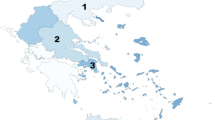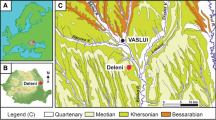Abstract
Indoor radon mapping may show stronger dependence on geological formations if the measured homes are one-storied houses with no basement. In Hungary, 17,244 homes were investigated on the yearly average of indoor radon concentrations; among these homes, there were 6,154, one-storied, no-basement houses. In Hungary, 21 geological units were created relevant for indoor radon index characterized by lithology, the position of the ground water table, and the gas permeability. Maps were drawn of different topography (counties, grid, geological units) and different values (maximum, mean, indoor radon indexes). A kind of standardization of houses was that only the one-storied, no-basement ones were chosen, but from geological point of view some more information was gained when the wall materials (bricks or adobe) were also taken into account. (“Adobe” is made of clay and straw in Hungary, and not burned as brick, just dried on sunshine). Enhanced indoor radon values can be observed on the bedrock of Cenozoic volcanic rocks and their eroded materials deposited on the local alluvial valleys. Another group with relatively increased indoor radon values can be connected to granite bodies. The grid method is useful for covering large state or even continental areas. For practical public use and detailed radon risk mapping geological or administrative unit-systems could yield more reasonable and useful results.







Similar content being viewed by others
References
Arvela H (1995) Seasonal variation in radon concentration of 3000 dwellings with model comparisons. Radiat Prot Dosimetry 59(1):33–42
Barnet I, Fojtikova I (2007) Soil gas radon, indoor radon and gamma dose rate in the Czech Republic—contribution to geostatistical methods for European Atlas of Natural Radiations. Proceedings of the 5th conference on protection against radon at home and at work, FJFI Prague (in print)
Efron B (1979) Bootstrap methods: another look at the jackknife. Ann Stat 7(1):1–26
European Comission Directorate General Joint Research Center European Forum on Radon Mapping. http://radonmapping.jrc.it. Cited 2005
Gunby JA, et al (1993) Factors affecting indoor radon concentrations in the United Kingdom. Health Phys 64(1):2–12
Hámori K, Tóth E, Losonci A, Minda M (2006) Some remarks on the indoor radon distribution in a country. Applied Radiation and Isotopes 64:859–863
Keller G, et al (1992) Indoor radon correlated with soil and subsoil radon potential–a case study. Environ Geol Water Sci 19(2):113–119
Kemski J, Klingel R, Siehl A, Valdivia-Machego M (2006) Radon risk prediction in Germany based on gridded geological maps and soil gas measurements. Paper presented at the 8th international workshop on the geological aspects of radon risk mapping, Prague, Czech Republic, 26–30 September 2006
Levesque B, et al (1997) Radon in residences: influences of geological and housing characteristics. Health Phys Soc 72(6):907–914
Miles JCH, Appleton JD (2005) Mapping variation in radon potential both between and within geological units. J Radiol Prot 25:257–276. doi:10.1088/0952-4746/25/3/003
Mose DG, Mushrush GW, Chrosniak CE (1992) Soil radon, permeabilití, and indoor radon prediction. Environ Geol Water Sci 19(2):91–96
Samuelsson L (1989) Radon indoors. Paper presented at the international conference on energy alternatives/risk education, national centre for educational technology, Veszprém, Hungary, 7–13 September 1989
Somlai J, et al (1998) Radiation hazard of coal-slags as building material in Tatabánya town (Hungary). Health Phys 75:648–651
Somlai J, et al (2005) Radiation dose from coal slag used as building material in the Transdanubian region of Hungary. Radiat Prot Dosimetry. doi:10.1093/rpd/nci323
Thomas J, et al (2002) Determination of radon prone areas by probabilistic analysis of indoor survey results and geological prognostic maps in the Czech Republic. Int Congr Ser 1225:49–54
Your Global Radon Advisor http://www.radon.eu/services.html. Cited 2006
Acknowledgments
The authors thank GVOP (Hungarian Economic Competitiveness Operational Program) for the support.
Author information
Authors and Affiliations
Corresponding author
Rights and permissions
About this article
Cite this article
Minda, M., Tóth, G., Horváth, I. et al. Indoor radon mapping and its relation to geology in Hungary. Environ Geol 57, 601–609 (2009). https://doi.org/10.1007/s00254-008-1329-6
Received:
Accepted:
Published:
Issue Date:
DOI: https://doi.org/10.1007/s00254-008-1329-6




